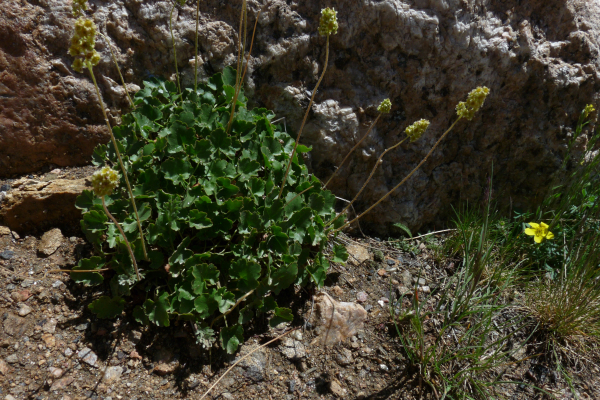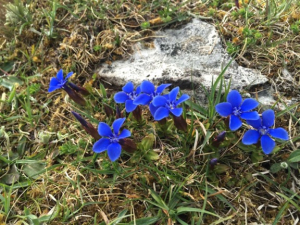At first glance, a rock would seem to be an inert thing offering no real benefit to plants and possibly harming them if its weight were to fall on the tender leaves or stems. But after observation, it becomes clear that rocks can nurture plants. How? The most obvious benefit is the channeling of water down the face of the rock into the soil surrounding the plant. The rock also shades the plant and surrounding soil, keeping it cool in summer’s heat. Rocks, particularly dark-hued ones, absorb heat during the day and radiate it out at night, mitigating the temperature swings that can damage developing plants. These factors add up to a rock’s ability to create a microclimate around it that makes a hospitable haven.
There are myriad other benefits. Protection from wind, landslides, and avalanche; the addition of small amounts of fertilizing minerals over time; these are just a few. It’s no wonder that many plants, especially the tiny vulnerable ones, prefer to grow among rocks.
Other species are adapted to grow on stones themselves. See the accompanying story about plants that grow on the limestone rock beds of Western Ireland, known as the Burren (p. 249). When mosses, lichens, and other bryophytes colonize rocks, they create a symbiotic relationship that is pleasing to the eye and spirit. “Nothing else seems to hold so much worldly example and welcoming comfort in so small a piece of the planet,” writes George Schenk in his book Moss Gardening. “Moss on stone is as a comforting hand on a human shoulder.”
My friend Michael Alcazar grew up in a family that valued its heritage being among the Muscogee peoples. “My grandmother taught me to plant a handful of grass seed, and then put a rock over it,” he said. In addition to the benefits mentioned above, the rock stabilized the earth, prevented erosion, and kept the seeds from washing away. This very simple technique allowed slopes to be revegetated. A rock on the downslope side of a plant creates a mini-terrace where pockets of vegetation can be established.
Rocks in depressions can take the form of a dry wash or arroyo. A dry streambed comes alive during a rain event, channeling water to and through trees and plants. Rain gardens are often filled with cobblestones or river rock, allowing surface water to sink and to be held underground as a bank to be drawn on in dryer weather.
A rock in a running stream creates turbulence that keeps the water oxygenated, which is beneficial to both the plants and organisms in the stream. When it comes to water, the straight and narrow path is not the most desirable. The path of least resistance is not the path to a watercourse’s health. There is an adage to “slow, sink, and spread water” and this is what stones do beautifully.
Landscapers often create swales, gentle depressions undulating between berms. I often see the lower parts of swales filled in with rocks, while the berms are topped with trees, shrubs, and grass. The most successful swales I’ve seen had grass and plants in the depressions and rocks around trees set into the berm’s shoulders. This is a better example of biomimicry; recognizing that rocks occur in outcroppings, while the depressions represent intermittent watercourses.
In the ancient Shinto religion of Japan, rocky outcroppings were thought to be the abodes of gods. Tomohiro Fujita and Kazuharu Mizuno studied these outcroppings in South African grasslands and found that they promoted more seedlings of woody species.1 Over time, the Japanese reverence for escarpments segued into the now-iconic form of a classic Japanese rock garden: just a few symbolic rocks in a symbolic sea or stream of white gravel. A typical rock arrangement might be a vertical stone complemented by a “reclining” or horizontal stone. In a small courtyard or teahouse garden, one stone might be balanced by one plant, typically bamboo.2
Blogger Robert Ketchell observed that “[Stones] are regarded as forming the essential skeleton of the garden, providing the garden layout with a fixed and subtle framework that will define the overall structure. Planting, that element of a garden so revered by Western garden makers, tends to be seen as adding flesh to the bones of a garden.”3
A rock in the garden is more than just a marker. Aesthetically, it can serve as a complementary or contrasting texture and form that interests and delights the eye of the viewer. Another contrast is the immobility of the rock with the swaying leaves and stems of the plant it nurtures. Writing about the Seattle Japanese Garden, Corinne Kennedy observed that strategically placed rocks create a triadic dynamic with plants and animals. Without the foundation and solidity of the rocks, the garden would be an ephemeral, shifting, and elusive structure.4
A well-structured, well-placed rock in the landscape is a grounding influence that can command and direct the eye. The very embodiment of gravitas, a rock can convey stability and permanence or energy, vitality, and power, sometimes all at the same time. Rocks protect. The epic of Nature is etched in the interplay of shadows and light to which they give longstanding witness. In their own way, rocks are ever at work, nursing and preserving the health of Earth and all its inhabitants.
References:
1. https://www.researchgate.net/publication/282400615_Role_of_nurse_rocks_o...
2. Ohashi, Haruzo, Japanese Courtyard Gardens, Graphic-sha Publishing Co., Tokyo, Japan, 1988.
3. https://robertketchell.blogspot.com/search?q=stone+setting+in+Japanese+g...
4. https://www.seattlejapanesegarden.org/blog/2019/9/19/stones-in-the-seatt...
Sidebar: Nurse Rocks in The Burren
Michael Campbell discovered the healing power of the nurse rock when working towards his diploma at Denver’s School of Botanical Art & Illustration. He visited the Burren on Ireland’s west coast for the first time in May 2015. “The place was completely different than I expected,” he recalled. “It was 40 degrees (4.4 °C) and the wind was blowing constantly. At first, I didn’t think any plants could flower in that climate. They were tiny, growing amongst the rocks. It was a real eye-opener.”
When he returned in August 2016, the weather had barely improved. “It was warmer but still rainy. I was astounded by the amount of flora growing in the limestone meadows.” The ferns grew right on the rocks, getting moisture from little cracks and divots. There were orchids everywhere, their delicate blooms sheltered by the limestone slabs and boulders.
It was the same with gentians. “The stone acts as a radiator,” he said, actually helping the flora to thrive in the harsh windswept climate. “Plants were growing wherever the limestone is,” he added. “The minerals shed by the rocks feed the plants.”
In May 2018, when Campbell most recently returned to the Burren, hundreds of gentians were coming up. “It was one of the most remarkable sights I’ve seen,” he said. “At that latitude, days are much longer in spring and summer. The Atlantic is right there. The wind is fierce. But the rocks make it possible for these unique species to thrive.”
Indeed, some kinds of plants flourish in the Burren better than almost anywhere else. Twenty-seven species of orchids grow there. The limestone of the Burren is so unique that when a road was being built, the topsoil was removed and taken to Dublin Botanic Garden where it was used to propagate and grow a mini-Burren garden.




